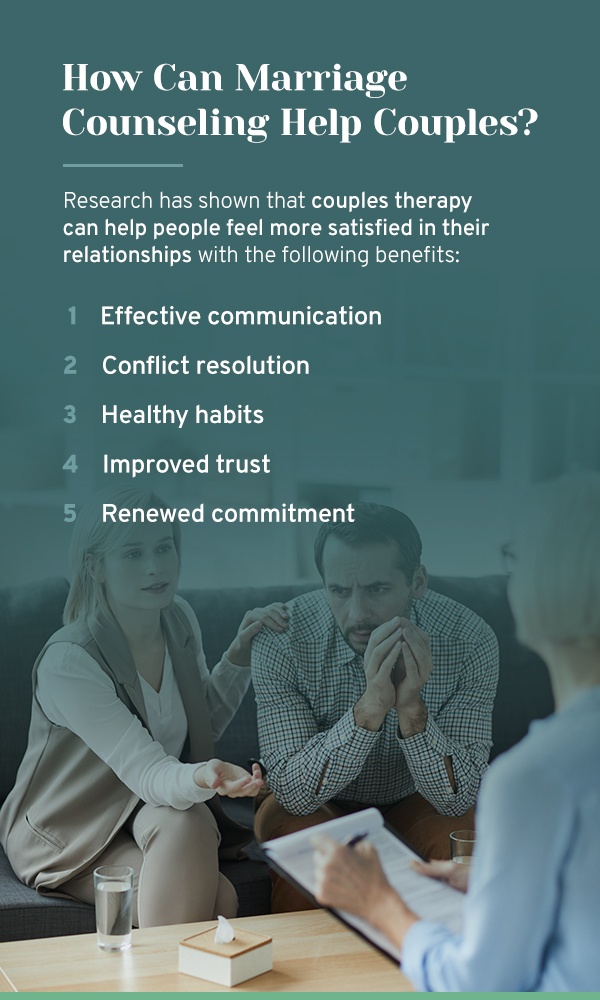Aim Point Counseling for Dummies
Aim Point Counseling for Dummies
Blog Article
Aim Point Counseling Fundamentals Explained
Table of ContentsWhat Does Aim Point Counseling Do?The smart Trick of Aim Point Counseling That Nobody is DiscussingThe 45-Second Trick For Aim Point CounselingAim Point Counseling - QuestionsNot known Factual Statements About Aim Point Counseling The Single Strategy To Use For Aim Point Counseling
The longitudinal style entails a pre-treatment study and two follow-up studies at 3- and 12-months post-intervention. The research is set in eight Relationships Australia Victoria centres, across cosmopolitan, external suburban areas, and regional/rural sites. Relationships Australia, a non-government organisation, is the largest service provider of pair counselling and connection solutions in Australia./assets/production/practices/42c324c45018d9ed1279a759bd3482c101ad073f/images/2588472.jpg)
These high prices of relationship failure have actually been regularly connected with negative health repercussions for both grownups and kids complying with divorce/separation.
An Unbiased View of Aim Point Counseling
The effects of divorce and splitting up can be damaging, study suggests that high partnership disharmony in undamaged pairs is likewise most likely to have negative results.
In addition, factors that influence the outcomes of these services require detailed examination. Study to date has recognized both couple and specific factors that may add to connection disharmony. These consist of relationship complete satisfaction and dedication at the couple level, and depression at the private level. Robust research to examine relationship-enhancing treatments in the area are limited.
Aim Point Counseling Things To Know Before You Get This
Consequently, while many researches indicate improvements in partnership complete satisfaction following pair counselling, they are restricted by the examples and procedures made use of, mostly temporary follow-up period, and evaluations that do not represent the dyadic nature of pair information. Partnership commitment, based on measures such as the Dedication Supply (CI) [19], is one more typically examined relationship end result.
To sum up, study indicates that couple-specific variables as well as specific factors may anticipate the end results of pair counselling and connection solutions. The causal direction of these partnerships, however, is much less clear. These monitorings are essential, since, to warrant and guide the application of connection services such as couple therapy, empirical evidence has to explore both the results of partnership solutions and the elements that anticipate successful treatment.
There is a growing agreement that efficiency research studies ought to be complemented by effectiveness research to best notify scientific technique [ 29] The restricted performance research that exists to date suggests that couple therapy can boost results such as relationship fulfillment [33,43], interaction skills and basic wellness [44], at the very least in some European nations.

We presently recognize little about the profiles of couples who look for relationship education and learning contrasted with those that look for connection coaching, or the results of these programs. However, unscientific evidence recommends that there might be significant distress among at the very least some pairs looking for relationship education. Partnership education and learning programs vary from pair therapy as they are usually highly structured, performed in groups, and concentrate on a combination of 4 elements; understanding, comments, cognitive modification, and abilities training [45]
The 5-Second Trick For Aim Point Counseling
Comments involves individuals finishing questionnaires concerning their connection (e.g. procedures of interpersonal issues), and getting information on what their ratings indicate. Cognitive-behavioural techniques promote altering cognitions to facilitate positive relationships.
These meta-analyses highlight restrictions in the existing literary works on connection education. This example profile may not represent customers that commonly offer for relationship education.
The Best Strategy To Use For Aim Point Counseling

Very little study has actually checked out the comparative advantages of pair coaching and partnership education programs. As customers are likely to self-select right into these service types, it is not clear whether particular connection distress profiles present to every service kind, or without a doubt whether there is an interaction between offering profile, service kind and outcome.
(https://www.intensedebate.com/people/a1mpoint)
Thus, we have actually consisted of a 12-month follow-up to assess longer-term trends and impacts.
Consequently, we propose to utilise multi-level analytical modelling procedures that regulate for the inter-dependence of pair information to analyze any treatment impacts. The specific objectives of the ECC research study are to: 1. Map profiles of customers looking for neighborhood agency-based pair coaching vs. partnership enhancement programs in regards to socio-demographic and connection signs (such as connection complete satisfaction, relationship dedication, interpersonal problems, and navigate here factors for participating in), along with health (such as clinical depression, basic health and wellbeing) and wellness solution usage (eg.
2. Identify whether couple coaching and partnership education services boost three- and twelve-month results for partnership fulfillment, dedication, and clinical depression, utilizing analytical analyses proper to couple information. 3. Identify the relative payments of client variables (individual and pair) and therapy/education elements to outcomes at 3- and 12-months, and to sustainability of results over time.
Some Of Aim Point Counseling
Multi-level modelling to figure out pre-post differences, controlling for dyadic (pair) level. To add to the literary works analyzing the effectiveness of community-based pair counselling. The results will aid medical decision-making in community-based partnership service setups, and specialist training. 3. To determine the loved one contributions of client/couple and treatment variables to results at 3- and 12-months, and to sustainability of results in time.
Report this page